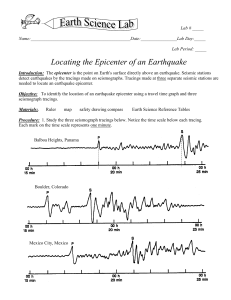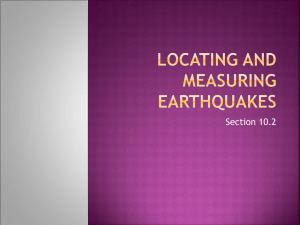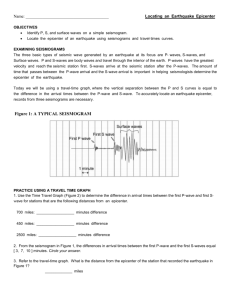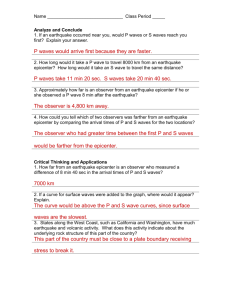Earthquakes: Finding the Epicenter
advertisement
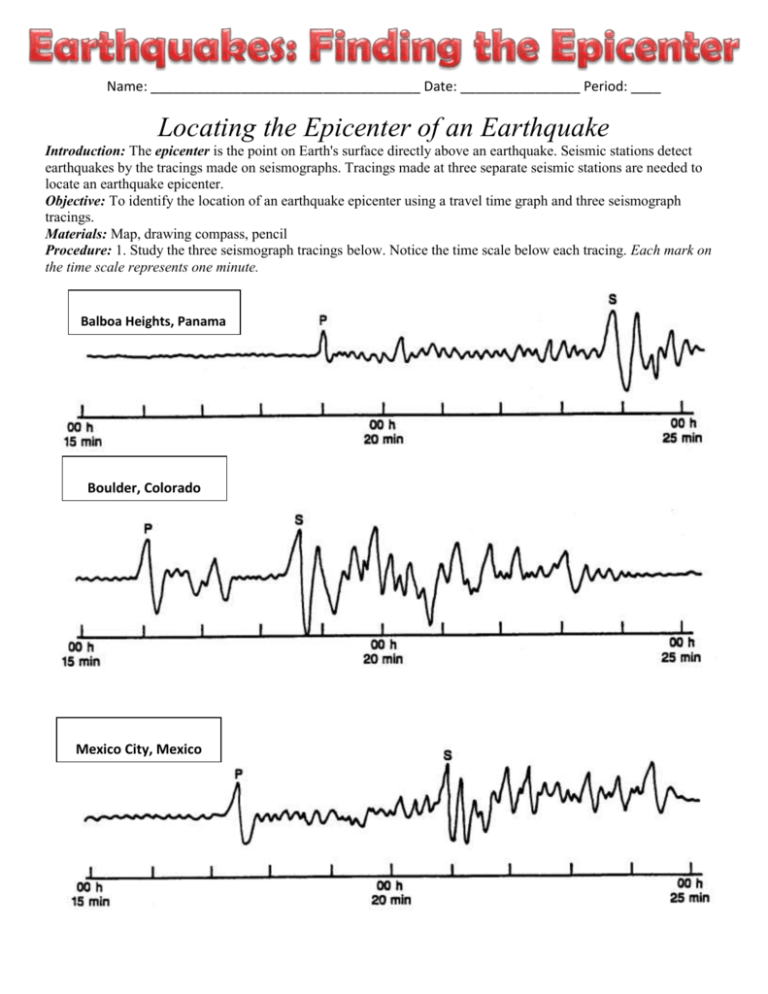
Name: ____________________________________ Date: ________________ Period: ____ Locating the Epicenter of an Earthquake Introduction: The epicenter is the point on Earth's surface directly above an earthquake. Seismic stations detect earthquakes by the tracings made on seismographs. Tracings made at three separate seismic stations are needed to locate an earthquake epicenter. Objective: To identify the location of an earthquake epicenter using a travel time graph and three seismograph tracings. Materials: Map, drawing compass, pencil Procedure: 1. Study the three seismograph tracings below. Notice the time scale below each tracing. Each mark on the time scale represents one minute. Balboa Heights, Panama Boulder, Colorado Mexico City, Mexico Date Table: City P-wave arrival time S-wave arrival time Difference between P-wave & S-wave Distance to epicenter Balboa Heights Boulder Mexico City 2. Start with the first tracing, labeled Balboa Heights. Locate the P, which indicates the arrival time of the P wave at the seismic station, and the S, which indicates the arrival time of the S wave. Draw a line straight down from the peak of the P wave to the time scale and another line from the peak of the S wave to the time scale. Record the arrival times on the data table. 3. Determine the difference between the arrival times of the P and S waves. For Balboa Heights, the time difference is about 4 min 50 sec. Do your data match this result? *4. Turn to the “Earthquake P-wave and S-wave Travel Time” graph. Lay the edge of a piece of paper along the vertical axis of the graph. Place a mark on the edge of the paper at 0 on the vertical axis and another mark corresponding to 4 min 50 s. Keeping the edge of the paper straight up and down, slide the paper across the graph to the place where the P and S curves are the same distance apart as the two points you marked. The point where the paper meets the distance scale at the bottom of the graph indicates the distance to the epicenter. Determine the distance to the epicenter from Balboa Heights. The distance for a time difference of 4 min 50 s is about 3200 km. Be sure to enter this information on the data table. 5. Now locate Balboa Heights on the map. Balboa Heights is marked BH. Place the point of your drawing compass at 0 on the map scale. Adjust the compass so that the pencil point is at 3200 km on the map scale. Without altering the compass, place the point at the center of the mark for Balboa Heights. Draw a circle with a radius of 3200 km around Balboa Heights. 6. Return to the seismograph tracings. Repeat procedure steps 2-6 for Boulder and Mexico City and complete the data table. Boulder is indicated on the map by BC and Mexico City is indicated by MC. Analysis and Conclusions 1. According to the reference tables, how long does.it take a P wave to travel 4000 km? 2. How long does it take an S wave to travel 4000 km ? 3. What is the difference in arrival times for a P wave and S wave that have traveled 4000 km? 4. What is the approximate distance to the epicenter if the difference in the arrival times of the P wave and S wave is 5.5 min? 5. As the distance to the epicenter increases, how does the amount of time between the S wave and the P wave change? 6. After drawing the first circle for Balboa Heights, where is the earthquake epicenter located relative to this one circle? 7. After drawing the circle for Boulder, you now have two circles on your map. Relative to these two circles, where is the earthquake epicenter? 8. After drawing the circle for Mexico City, you now have three circles on your map. Relative to the three circles, where is the earthquake epicenter? 9. You just found the epicenter of an earthquake! Explain how this knowledge is helpful for seismologists and why more research into earthquakes is important. 10. Assume seismologists had no knowledge of faults or epicenters, how might that impact our lives today? Give an example: 10. Would it be possible for an earthquake at this same location to be felt where you live? Why or why not?

